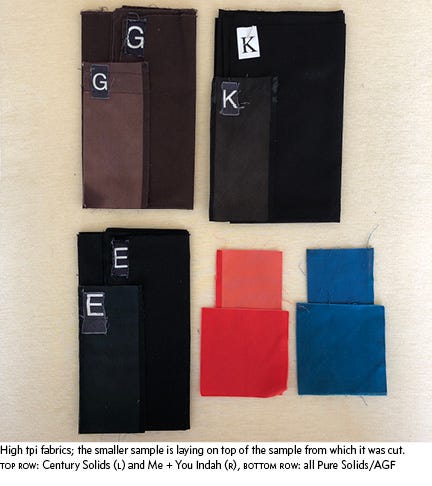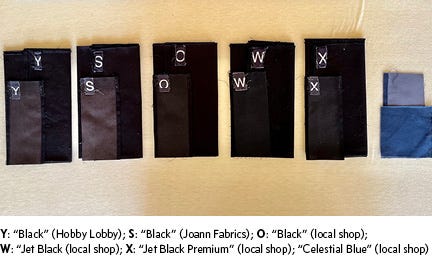Solid Quilting Cotton – Results from the Fading Test
This newsletter reports the results from the “fading from sunlight exposure” test I mention in my “Comparing Solid-Color Quilting Fabric” newsletter
History
I was keenly interested in a fading test because of an Amish-inspired quilt I made about 30 years ago. To get some liveliness within the black background I opted to use two brands of black fabric. I thought it looked great – very subtle, just the effect I was after. Unfortunately, the two black fabrics faded very differently and the result is far different than my original vision.
The Test
My brother, who lives in Tucson, Arizona, installed squares of washed black fabric (along with three non-black fabrics I also included) on the inside of his south-facing garage windows from mid-February, 2023 to mid-July, 2023. My thinking was that the garage glass was unlikely to be coated with the highest levels of UV protection and that six months in the intense Arizona sun would accelerate fading in such a way that I could assess how fabrics were likely to fade over 20-30 years of normal indoor light exposure (I totally made up that time frame). Arizona did not disappoint!
The Results
I was stunned by the amount, and variation, of the fading. I laid out all the samples and they naturally sorted into five groups, which I coded on a 1 to 5 scale, with 1 having the most fading and 5 having the least. The fabrics listed below are in order of the most fading to least fading (though within each score grouping the difference is minimal).
SCORE 1 (most faded)
Cirrus by Cloud 9 (“Midnight”/organic)
Ruby + Bee by Whindam
Mod Basics by Birch Organics (organic)
Confetti Cotton Solids by Riley Blake Designs
American Made Brand/AMB by Clothworks
Century Solids by Andover Fabrics (high tpi)
SCORE 2 (very faded)
Me + You Indah Solids by Hoffman (high tpi)
Cotton Supreme Solids by RJR Fabrics
Kona by Robert Kaufman (‘Black” from JOANN)
Kona by Robert Kaufman (“Black” from Hobby Lobby)
SCORE 3 (less fading than 2 but still prone to fading)
Everyday Organic Solids by Clothworks (organic)
Solid line by Connecting Threads
Cotton Couture Solids by Michael Miller
Pure Solids by Art Gallery Fabrics/AGF (high tpi)
SCORE 4 (acceptable, minimal fading)
Colorworks Premium Solid 9000 by Northcott
Kona by Robert Kaufman (“Black” from local high-end shop)
Painter's Palette Solids by Paintbrush Studio/PBS
Kona by Robert Kaufman (“Jet Black Premium” from local high-end shop)
SCORE 5 (very little fading)
Bella Solids by Moda Fabric
Designer Essential Solids by Free Spirit Fabrics
Kona by Robert Kaufman (“Jet Black” from local high-end shop)
Conclusions
High thread-per-inch (tpi) fabrics
Remember in the original “Comparing Solids” post I discussed learning that solid quilting fabric comes, broadly, in one of two types: high tpi fabric and low tpi fabric. As you can see in the photo below, [E] Pure Solids (AGF) had the least amount of fading the high tpi category, though it only scored a 3. Note however, that Pure Solids faded to a very cool grey while [K] Me + You (Score = 2) faded to a very warm grey. Depending on the other colors in your quilt, you might keep this in mind when choosing between these fabrics. With a score of 1, [G] Century Solids, which was a dark brown to start, faded the most of the high tpi fabrics.
When I cut the swatches for my brother to put in his windows I added in two extra Pure Solids (AGF) fabric swatches, a tomato red and a teal blue. The red faded to a salmon color (Score = 1) while the blue barely faded at all (Score = 5).
Kona fabrics
Remember also that I discussed comparing Kona fabric samples which were purchased from Joann Fabrics, Hobby Lobby, and a small locally owned quilt shop, along with discussing Kona’s various solid black fabrics: Black, Jet Black, and Jet Black Premium.
From my other testing I came to the conclusion that “Black” Kona purchased at JoAnn and Hobby Lobby were the same fabric as “Black” Kona purchased at a small independent shop. I am now less confident that that is true. The “Black” Kona samples that were purchased at Joann Fabrics and Hobby Lobby faded to brown, scoring only a 2. The “Black” Kona purchased at a small independent shop faded to a dark cool grey, scoring a 4. The “Jet Black” and “Premium Jet Black” Kona samples also faded to a dark cool grey, though the overall amount of fading was slightly less than the “Black” purchased at the local shop. These both scored a 5.
I also tested a sample of Kona’s Celestial Blue (a beautiful deep blue), which faded to a dull grey, Score=1). I purchased this blue fabric at a terrific little locally-owned store near Cambridge, MA.
I am not sure what to make of these results, given that both Jet Black samples from Kona that were purchased at local shops faded so little, while the black purchased at the large chain stores faded a lot. My best guess is that only the “nicer” blacks from Kona have the fade-resistant property and that all the other Kona colors, which do not come in premium versions, are the same fabric being sold at the big chains and the local shops. This does make me think that an additional fade test that compares the fading of Kona red, yellow, and blue fabrics bought at a local shop and a chain shop might settle the question of whether the same Kona fabrics are being sold at chain shops as at locally-owned shops once and for all.
Conclusion
I love the look of things as life wears them down. Call it patina, call it wabi-sabi, I believe that signs of age tell a story and that that story has value. That said, I would be very disappointed if a quilt I made faded to the point of being distorted, especially if it could have been largely avoided by my choice of fabric. As a result, I will weigh the results of the fading test quite heavily when choosing fabric in the future.







